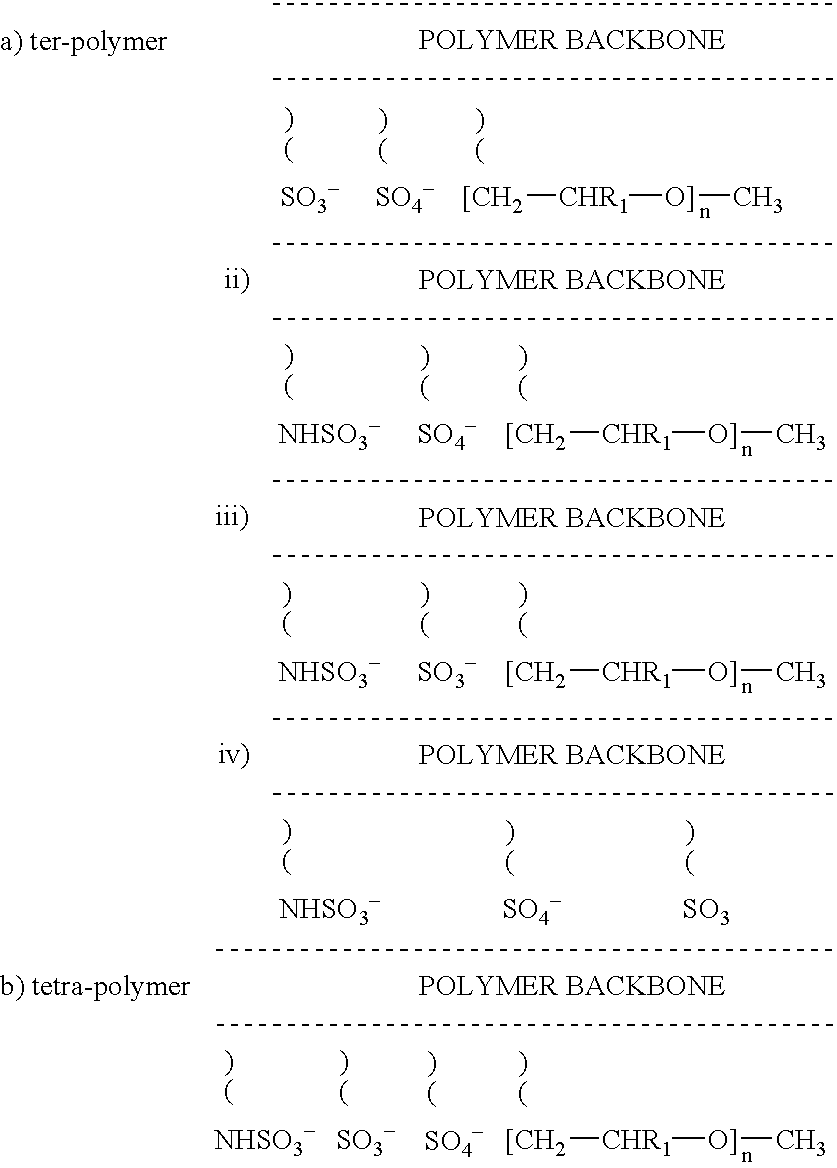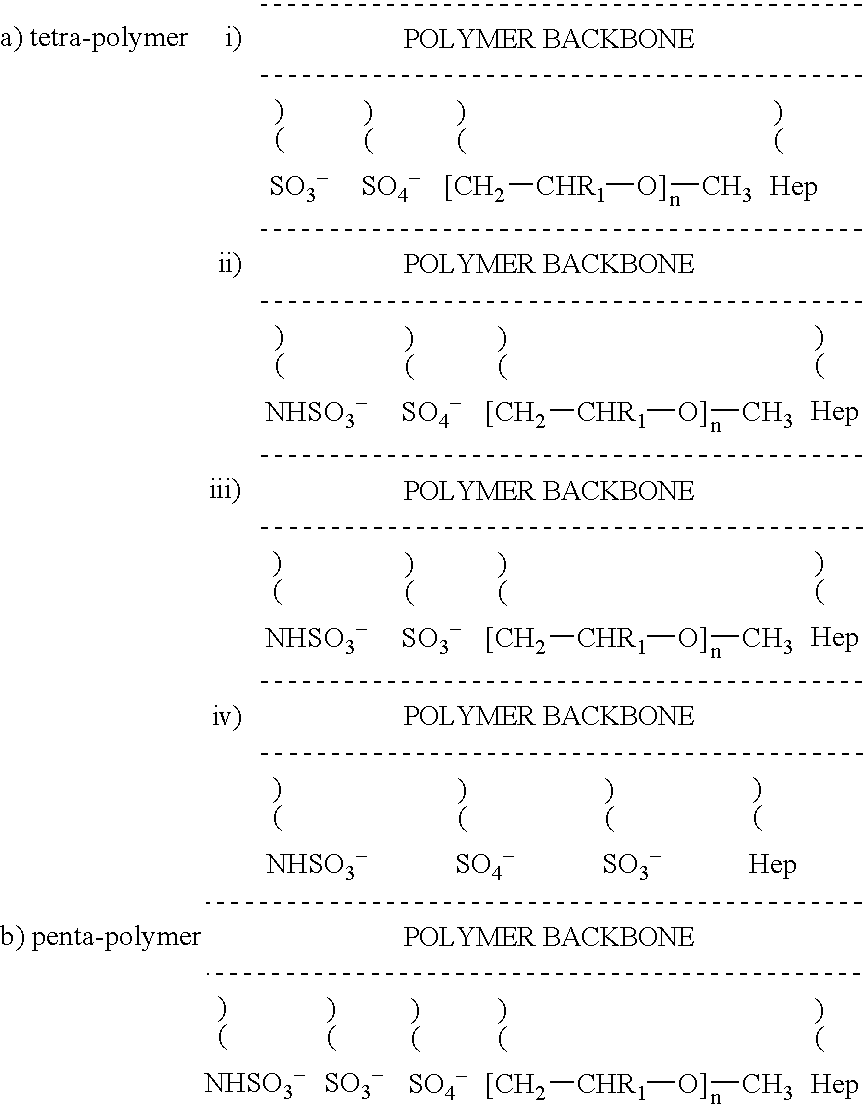Non-thrombogenic and anti-thrombogenic polymers
a polymer and anti-thrombosis technology, applied in the field of non-thrombosis and anti-thrombosis polymers, can solve the problems of limited success and therefore application, complex procedures used to produce these materials, and non-thrombosis of polymers, etc., to achieve enhanced stability of attachment, good coverage, and severe impact on performan
- Summary
- Abstract
- Description
- Claims
- Application Information
AI Technical Summary
Benefits of technology
Problems solved by technology
Method used
Image
Examples
example 1
[0089]Methoxy polyethyleneglycol methacrylate (MPEG METH., n=13, 9.0 g), ammonium sulphatoethyl methacrylate (25% aqueous solution, 45 g) and vinyl sulphonic acid sodium salt (25% aqueous solution, 13 g) were added to a 250 ml conical flask. The contents of the flask were degassed for 30 minutes, followed by bubbling with nitrogen and then heating to 75° C. Potassium persulphate (100 mg) was dissolved in water (15 ml) and added to the flask to start polymerisation. The reaction was allowed to continue for 15 minutes after which a very viscous solution was obtained. The reaction was stopped by pouring the contents of the flask into a beaker containing cold water (100 ml). The resultant polymer was dialysed against 10 litres of water in cellulose acetate membrane, M.W. cut off at 12,000 to 14,000. The polymer was removed and concentrated to 150 ml and stored at 5° C. The anionic portion of the polymer composition can be illustrated as follows:
[0090]
example 2
[0091]Methoxy polyethyleneglycol methacrylate (MPEG METH., n=13, 7.7 g), ammonium sulphatoethyl methacrylate (25% aqueous solution, 4.0.8 g) and 2-sulphamatoethyl methacrylamide (25% aqueous solution, 22.4 g) were added to a 250 ml conical flask. The contents of the flask were degassed for 30 minutes, followed by bubbling with nitrogen and then heating to 75° C. Potassium persulphate (100 mg) was dissolved in water (15 ml) and added to the flask to start polymerisation. The reaction was allowed to continue for 15 minutes after which a very viscous solution was obtained. The reaction was stopped by pouring the contents of the flask into a beaker containing cold water (100 ml). The resultant polymer was dialysed against 10 liters of water in cellulose acetate membrane, M.W. cut off at 12,000 to 14,000. The polymer was removed and concentrated to 150 ml and stored at 5° C. The anionic portion of the polymer composition can be illustrated as follows:
[0092]
example 3
[0093]Methoxy polyethyleneglycol methacrylate (MPEG METH., n=13, 8.6 g), 2-sulphamatoethyl methacrylamide (25% aqueous solution, 45.2 g) and vinyl sulphonic acid sodium salt (25% aqueous solution, 14.4 g) were added to a 250 ml conical flask. The contents of the flask were degassed for 30 minutes, followed by bubbling with nitrogen and then heating to 75° C. Potassium persulphate (100 mg) was dissolved in water (15 ml) and added to the flask to start polymerisation. The reaction was allowed to continue for 15 minutes after which a very viscous solution was obtained. The reaction was stopped by pouring the contents of the flask into a beaker containing cold water (100 ml). The resultant polymer was dialysed against 10 liters of water in cellulose acetate membrane, M.W. cut off at 12,000 to 14,000. The polymer was removed and concentrated to 150 ml and stored at 5° C. The anionic portion of the polymer composition can be illustrated as follows:
[0094]
PUM
| Property | Measurement | Unit |
|---|---|---|
| pH | aaaaa | aaaaa |
| hydrophilic | aaaaa | aaaaa |
| concentration | aaaaa | aaaaa |
Abstract
Description
Claims
Application Information
 Login to View More
Login to View More - R&D
- Intellectual Property
- Life Sciences
- Materials
- Tech Scout
- Unparalleled Data Quality
- Higher Quality Content
- 60% Fewer Hallucinations
Browse by: Latest US Patents, China's latest patents, Technical Efficacy Thesaurus, Application Domain, Technology Topic, Popular Technical Reports.
© 2025 PatSnap. All rights reserved.Legal|Privacy policy|Modern Slavery Act Transparency Statement|Sitemap|About US| Contact US: help@patsnap.com



